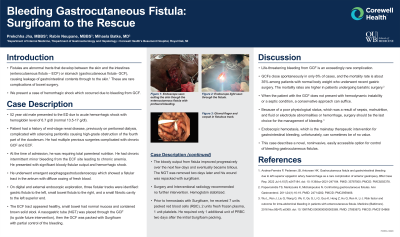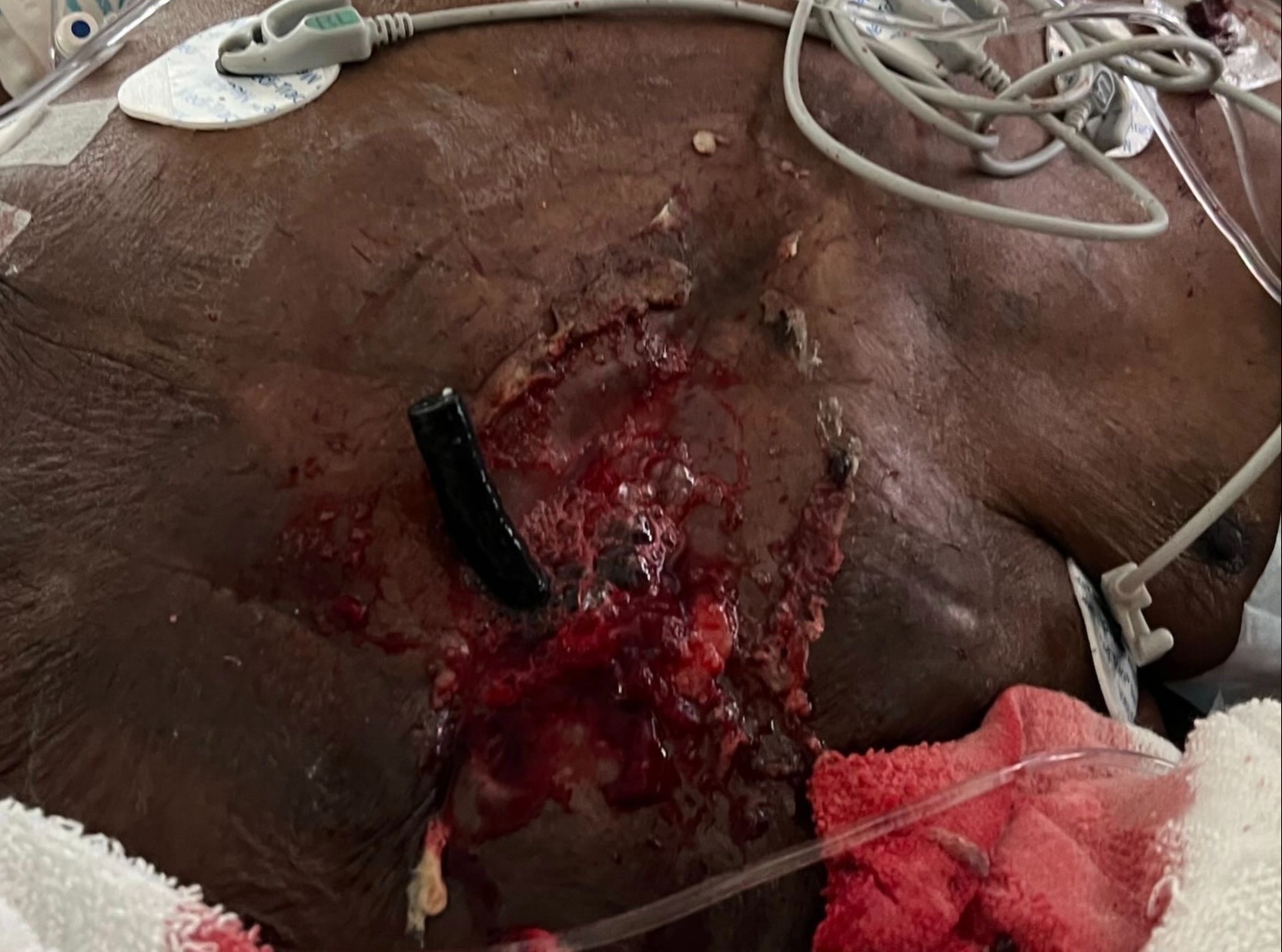Tuesday Poster Session
Category: GI Bleeding
P3523 - Bleeding Gastrocutaneous Fistula: Surgifoam to the Rescue
Tuesday, October 24, 2023
10:30 AM - 4:00 PM PT
Location: Exhibit Hall

Has Audio
.jpg)
Prekchha Jha, MBBS
Corewell Health
Royal Oak, MI
Presenting Author(s)
Prekchha Jha, MBBS, Rabin Neupane, MBBS, Mihaela Batke, MD
Corewell Health, Royal Oak, MI
Introduction: Fistulas are abnormal tracts that develop between the skin and the intestines (enterocutaenous fistula – ECF) or stomach (gastrocutaneous fistula- GCF), causing leakage of gastrointestinal contents through to the skin. These are rare complications of bowel surgery. We present a case of hemorrhagic shock which occurred due to bleeding from GCF.
Case Description/Methods: 52 year old male presented to the ED due to acute hemorrhagic shock with hemoglobin level of 6.7 g/dl (normal 13.5-17 g/dl). Patient had a history of end-stage renal disease, previously on peritoneal dialysis, complicated with sclerosing peritonitis causing high-grade obstruction of the fourth part of the duodenum. He had multiple previous surgeries complicated with chronic GCF and ECF. At the time of admission, he was requiring total parenteral nutrition. He had chronic intermittent minor bleeding from the ECF site leading to chronic anemia. He presented with significant bloody fistular output and hemorrhagic shock. He underwent emergent esophagogastroduodenoscopy which showed a fistular tract in the antrum with diffuse oozing of fresh blood. On digital and external endoscopic exploration, three fistular tracks were identified: gastric fistula to the left, small bowel fistula to the right, and a small fibrotic cavity to the left superior end. The ECF tract appeared healthy, small bowel had normal mucosa and contained brown solid stool. A nasogastric tube (NGT) was placed through the GCF (to guide future intervention), then the GCF was packed with Surgifoam with partial control of the bleeding. The bloody output from fistula improved progressively over the next few days and eventually became bilious. The NGT was removed 2 days later and his wound was repacked with surgifoam. Surgery and Interventional radiology recommended no further intervention. Hemoglobin stabilized. Prior to hemostasis with Surgifoam, he received 7 units packed red blood cells (RBC), 2 units fresh frozen plasma, 1unit platelets. He required only 1 additional unit of PRBC 2 days after the initial Surgifoam packing.
Discussion: Life-threatening bleeding from GCF is an exceedingly rare complication. Endoscopic hemostasis, which is the mainstay therapeutic intervention for gastrointestinal bleeding, unfortunately is of limited value in such cases. This case describes a novel, noninvasive, easily accessible option for control of bleeding gastrocutaneous fistulas.

Disclosures:
Prekchha Jha, MBBS, Rabin Neupane, MBBS, Mihaela Batke, MD. P3523 - Bleeding Gastrocutaneous Fistula: Surgifoam to the Rescue, ACG 2023 Annual Scientific Meeting Abstracts. Vancouver, BC, Canada: American College of Gastroenterology.
Corewell Health, Royal Oak, MI
Introduction: Fistulas are abnormal tracts that develop between the skin and the intestines (enterocutaenous fistula – ECF) or stomach (gastrocutaneous fistula- GCF), causing leakage of gastrointestinal contents through to the skin. These are rare complications of bowel surgery. We present a case of hemorrhagic shock which occurred due to bleeding from GCF.
Case Description/Methods: 52 year old male presented to the ED due to acute hemorrhagic shock with hemoglobin level of 6.7 g/dl (normal 13.5-17 g/dl). Patient had a history of end-stage renal disease, previously on peritoneal dialysis, complicated with sclerosing peritonitis causing high-grade obstruction of the fourth part of the duodenum. He had multiple previous surgeries complicated with chronic GCF and ECF. At the time of admission, he was requiring total parenteral nutrition. He had chronic intermittent minor bleeding from the ECF site leading to chronic anemia. He presented with significant bloody fistular output and hemorrhagic shock. He underwent emergent esophagogastroduodenoscopy which showed a fistular tract in the antrum with diffuse oozing of fresh blood. On digital and external endoscopic exploration, three fistular tracks were identified: gastric fistula to the left, small bowel fistula to the right, and a small fibrotic cavity to the left superior end. The ECF tract appeared healthy, small bowel had normal mucosa and contained brown solid stool. A nasogastric tube (NGT) was placed through the GCF (to guide future intervention), then the GCF was packed with Surgifoam with partial control of the bleeding. The bloody output from fistula improved progressively over the next few days and eventually became bilious. The NGT was removed 2 days later and his wound was repacked with surgifoam. Surgery and Interventional radiology recommended no further intervention. Hemoglobin stabilized. Prior to hemostasis with Surgifoam, he received 7 units packed red blood cells (RBC), 2 units fresh frozen plasma, 1unit platelets. He required only 1 additional unit of PRBC 2 days after the initial Surgifoam packing.
Discussion: Life-threatening bleeding from GCF is an exceedingly rare complication. Endoscopic hemostasis, which is the mainstay therapeutic intervention for gastrointestinal bleeding, unfortunately is of limited value in such cases. This case describes a novel, noninvasive, easily accessible option for control of bleeding gastrocutaneous fistulas.

Figure: Endoscope seen exiting the skin though the Gastrocutaneous fistula with profound bleeding.
Disclosures:
Prekchha Jha indicated no relevant financial relationships.
Rabin Neupane indicated no relevant financial relationships.
Mihaela Batke indicated no relevant financial relationships.
Prekchha Jha, MBBS, Rabin Neupane, MBBS, Mihaela Batke, MD. P3523 - Bleeding Gastrocutaneous Fistula: Surgifoam to the Rescue, ACG 2023 Annual Scientific Meeting Abstracts. Vancouver, BC, Canada: American College of Gastroenterology.
